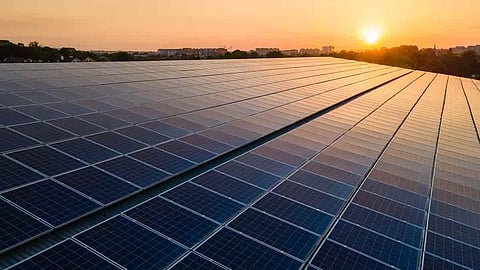

New Delhi: Santosh Kumar Sarangi, Secretary, Ministry of New and Renewable Energy (MNRE), said on Friday that that the ministry is in regular discussions with the Ministry of Finance on new schemes to support Renewable Energy (RE) expansion, with a particular focus on floating solar and agrivoltaic solutions that can be deployed without requiring large land parcels.
Follow Energy Watch on X
While addressing FICCI's 98th Annual General Meeting and Annual Convention, Sarangi asserted that India’s energy demand will increase exponentially, necessitating a proper energy mix that includes RE, nuclear, and coal power to ensure baseload management and capacity addition. He cited the target of 500 GW of RE capacity by 2030 and a projected 1,800 GW by 2047, with solar accounting for the majority, underscoring the vital role of RE.
Sarangi acknowledged that transmission remains a challenge due to the long gestation period of high-voltage lines (4 to 5.5 years) compared to RE projects (1 to 2 years). To address the grid lag, he highlighted initiatives such as CERC regulations, splitting NIA, and encouraging distributed RE (eg, agri-photovoltaics in agriculturally rich states and floating solar in the NER) to reduce land-related issues. He noted that the Green Energy Corridor scheme is adding circuit kilometres to upgrade state evacuation infrastructure.
Addressing tariff sustainability, he explained that the slightly higher rates (around Rs 2.50) are a conscious policy decision to encourage domestic manufacturing (DCR requirement) and achieve self-reliance (Atmanirbhar) in line with the target of 1,800 GW.
Sarangi expressed great confidence in technological breakthroughs like perovskite solar cells, which have the potential to reduce electricity costs to Rs 1.00 per unit if stability for 25 years can be established. He further stressed the critical role of states in allocating land, facilitating evacuation, and accepting Power Purchase Agreements (PPAs), citing the catalytic impact of schemes like PM-KUSUM in helping states reduce discom losses from agricultural feeders and rural households.
Vipul Tuli, Chair, FICCI RE CEOs Committee and President & CEO – Renewables West, Sembcorp Industries, in his remarks, analysed the macro challenges, particularly the grid, and proposed the next frontier for investment. He commended India’s “amazing” achievements in sustainability and renewables, noting that the models are commercially savvy, which has driven adoption, but stressed that demand growth is virtually unsatiated due to a large population, rising cooling demand, and data centre growth.
He acknowledged the significant gap between India’s annual RE capacity additions (around 42 GW) and China’s (421 GW), as well as the higher solar tariffs in India (Rs 2.50) compared to the Middle East (Rs 1.00).
Tuli called India’s national grid an outstanding global asset but cautioned that it is “not expanding fast enough.” He urged that grid developers be given “special powers” to accelerate land acquisition and rights-of-way approvals. He identified green fuels and carbon capture (CCUS) as the “next horizon,” noting that global carbon-capture costs are declining—from USD 30–40 per ton, with the potential to fall further to USD 10–20 per ton.
Follow Energy Watch on LinkedIN
Tuli also suggested that CCUS, coupled with green chemicals and biomaterials (biomethane, bioethanol), could spawn a large industry, potentially larger than renewables, with 80 percent to 90 percent local content, representing a significant opportunity for CapEx and growth.
